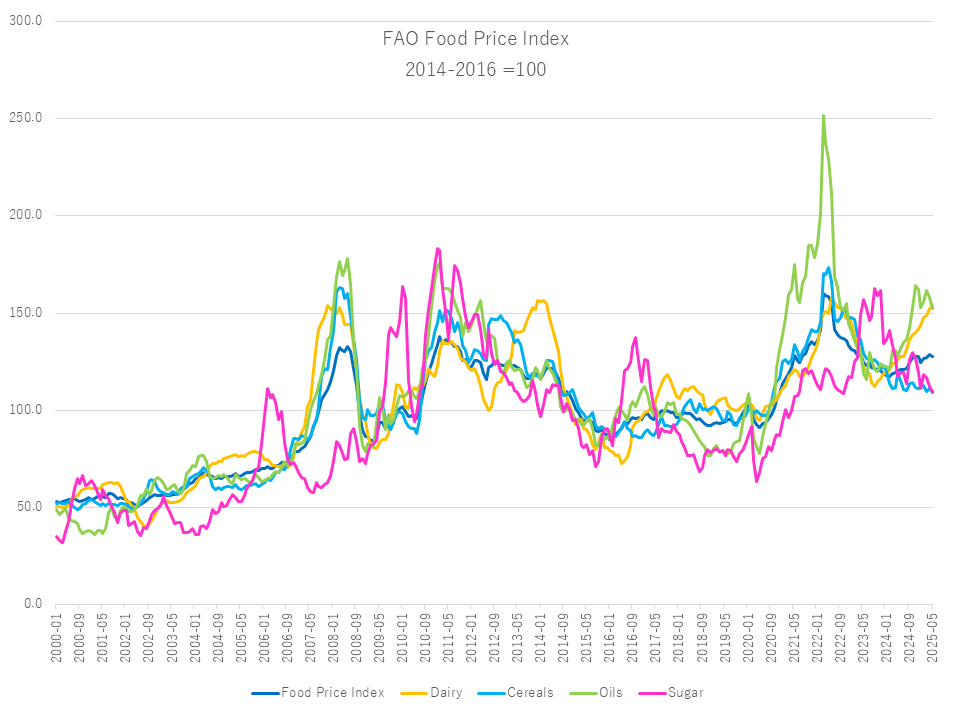Pick Up
1273. World Food Price Trends in May 2025

1273. World Food Price Trends in May 2025
The Food and Agriculture Organization of the United Nations (FAO) announced the world food price trend on June 6, with the average for May 2025 being 127.7 points, down 0.8% from April. The dairy and meat price indexes rose, offset by declines in the cereal, sugar, and vegetable oil price indexes. The food price index is 6.0% higher than a year ago, but remains 20.3% lower than the peak recorded in March 2022.
The cereal price index was at 109.0 points, down 1.8% from April and 8.2% from a year ago. World corn prices fell due to intense competition and seasonally higher supplies from harvests in Argentina and Brazil that outpaced last year's pace. Expectations of a record 2025 corn harvest in the United States also added to downward pressure on prices. International wheat prices also fell moderately due to weak global demand and improving crop conditions in the Northern Hemisphere, while rains towards the end of the month reduced the risk of drought in Europe, the Black Sea region, and parts of the United States. Meanwhile, the rice price index rose 1.4% in May, reflecting strong demand for aromatic rice and rising prices for indica rice, which was also influenced by the appreciation of some exporting countries' currencies against the US dollar.
The vegetable oil price index averaged 152.2 points in May, down 3.7% from April but still up 19.1% year-on-year. The continued decline reflects lower market prices for palm oil, rapeseed oil, soybean oil, and sunflower oil. International palm oil prices fell sharply for the second consecutive month and have remained at a discount to competing oils since mid-April. The decline was mainly driven by seasonal production increases and weak export supplies in Southeast Asia. Global soybean oil prices also fell, pressured by rising supplies in South America and weak demand for biofuel feedstocks, especially in the United States.
The meat price index rose 1.3% from April and was up 6.8% year-on-year. The increase was driven by higher international prices for beef, sheep, and pork, which more than offset the decline in poultry prices. Global beef prices hit a new record high on the back of robust global demand and tight export supplies in major producers. Meanwhile, poultry prices were under downward pressure as a growing oversupply was exacerbated by the detection of highly pathogenic avian influenza at a commercial farm in Brazil in mid-May, leading to import bans from several major importing countries.
The dairy price index rose 0.8% month-on-month and 21.5% year-on-year. International butter prices remained at historic highs, buoyed by robust demand from Asia and the Middle East amid tight milk supplies in Australia. However, price gains were limited by a slowdown in demand for butter from the European Union. Cheese prices rose for the second consecutive month, driven by sustained demand from the foodservice industry, particularly in East and Southeast Asia, and tight supplies within the EU due to adverse weather and disease outbreaks earlier in the year.
The May average sugar price index fell 2.6% from April, marking the third consecutive month of declines and 6.6% below May 2024 levels. The decline was driven by weak global sugar demand due to concerns over global economic uncertainty and its potential impact on demand in the beverage and food processing industries. In addition, early forecasts that global sugar production may recover in 2025/26 due to an early arrival of the monsoon season and expected increased production in India and Thailand also put further downward pressure on prices.
Contributor: IIYAMA Miyuki, Information Program
